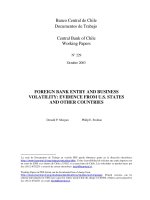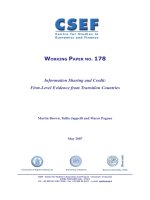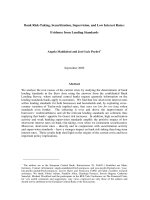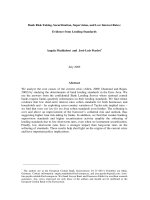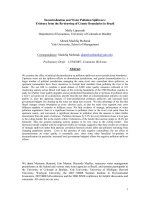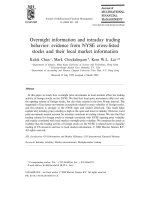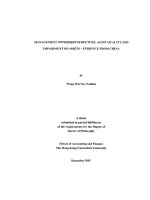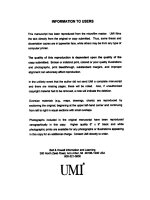Dividend policy and share price volatility: Evidence from Jordan
Bạn đang xem bản rút gọn của tài liệu. Xem và tải ngay bản đầy đủ của tài liệu tại đây (374.59 KB, 11 trang )
Accounting and Finance Research
Vol. 8, No. 2; 2019
Dividend Policy and Share Price Volatility: Evidence from Jordan
Dr. Sufian Radwan Almanaseer1
1
Business Economic Department, Business Faculty, Tafila Technical University, Jordan
Correspondence: Dr. Sufian Radwan Almanaseer, P. O. Box 179, Tafila 66110, Jordan. E-mail:
Received: February 17, 2019
doi:10.5430/afr.v8n2p75
Accepted: March 15, 2019
Online Published: March 18, 2019
URL: />
Abstract
The aim of this study was to study the relationship between dividend policy and share price volatility in insurance
companies listed in the Amman Stock Exchange. A sample of 20 companies from 23 insurance companies listed in
the Amman Stock Exchange was selected. The current study used two main measurements of dividend policy,
dividend yield, and payout ratio, by applying multiple linear regressions for the period 2008 to 2017. The main
regression model was modified by adding control variables including firm size, earnings volatility, financial leverage
and growth in assets. The study finds a significant negative relationship between share price volatility and dividend
yield and payout ratio. But the most impact variable on share price volatility was dividend yield.
Keywords: dividend policy, dividend yield, insurance companies, payout ratio, share price volatility
1. Introduction
One of the most important disputed decisions made by companies is the dividend policy, in addition to its role in
saving money as an alternative of the banking by which companies can find sources for financing their investments
relying on retained earnings which are one of the internals financial sources. This might contradict the process of the
dividend policy which is considered as a very important issue for the investors who believe in less risk (Boca, 2011),
as assumed in Miller and Modigliani's theory (1961) that stated in case of the optimal capital market, the decision of
cash dividend to shareholders and its amount might have no effect on the company value (Miller and Modigliani,
1961), while Boca (2011) indicates that shareholders care about the dividend policy in company which influences the
development of the company and its investments growth.
Consequently, Onofrei (2003) and Toma et al. (2003) illustrate that by adopting a clear policy in the company
concerning the dividend, this will strengthen the investors' trust in the company and achieve their point of view about
the stability of dividends and the capability of the company to do that. This will maintain stability at the share price
in the stock markets. Moreover, Bărbuţă-Mişu (2010) find that dividend policy considered one of the main subjects
for the decision to invest in the company. This is reflected in the price and demand for shares. Additionally, Toma
and Brezeanu (1996) assure that dividend policy is one indicator for the performance in the company in comparison
with other competitive companies and the increase in the share price after announcing the increase in the dividend is
consistent with previous studies (Koch and Sun, 2004; Dhaliwal, Erickson, and Trezevant, 1999; Graham and Kumar,
2006; Dahlquist, Robertsson, and Rydqvist, 2007; Hotchkiss and Lawrence, 2007; and Desai and Jin, 2011).
Lintner (1956) was the first that highlighted the dividend policy by assuring that most administrations avoided
making any modifications in ratios of the dividend which might be changed in the following years. While
Bhattacharya (1979), John and Williams (1985) and Miller and Rock (1985) suggested that the companies used the
changes in the dividend in order to clarify their future attitudes and, accordingly, managers have information about
the dividend more than any outsourced concerning the increase in share price. Based on Arnold (2008) and Lee
(2009), the managers, after payment of the interest and taxes, could distribute the dividend to the shareholder as a
part of the net income, retained earnings or reinvest them in the company to increase the share price.
The announcing of the dividend is considered as a difficult decision that the administration should make because of
its influence on investors and company, and the necessity to coordinate between the distributed and the retained
earnings which are needed to finance the company processes. This conforms to the questions raised by Lintner
(1956):
1- Which better change the current ratio of the dividend or to keep them?
Published by Sciedu Press
75
ISSN 1927-5986
E-ISSN 1927-5994
Accounting and Finance Research
Vol. 8, No. 2; 2019
2- Do the shareholders want to gain fixed dividend or dividend related to the earnings?
3- Which kind of dividend policy attracts investors?
The main aim of this study is to study the relationship between dividend policy and share price volatility in insurance
companies listed in the Amman Stock Exchange. By exploring the relationship between dividend policy and share
price volatility, this study expects to help management’s and investor’s in predicting how the share price will act.
The limitations of the study, the study is only conducted on the Jordanian insurance companies listed in the Amman
Stock Exchange for the period 2008-2017
The study is structured as follows: at first, a review of literature about the dividend policy and share prices. The
second part is the theoretical framework and review of related studies. The third part is the methodology used in the
study, methods of data collection, the sample, the model of the study, the method of measuring variables and
statistical analysis. Forth part is for discussion of results and recommendations.
2. Theoretical Part and Related Studies
Dividend policy is considered as a strategic alternative of companies in order to determine the source of finance for
its investment decisions. However, this policy is controlled by some factors such as investors preference, earnings,
opportunities of investment, governmental policies and taxes, so a big number of dividends is regarded as a message
of low risk to other parts. All of these affect the stock exchange in the markets (Gordon, 1963; Baskin, 1989). There
are varied forms of dividend such as cash dividend, distribution of shares, share split and repurchase of stock. Thus,
the important question is about the forms, the amounts of this dividend and its effect on share prices (Baskin, 1989).
There are three schools of thoughts concerning the relationship between the dividend policy and share price
(Damodaran, 2010): The first school maintains that no effect for the dividend policy on the share price and the
company value (Miller and Modigliani, 1961; Black and Scholes, 1974). The second one assumes that the dividend
is bad for shareholders due to tax deprivation that leads to a low value (Brennan, 1970; Litzenberger and
Ramaswamy, 1979). Whilst the third one indicates that the dividend is preferable for shareholders because it
increases their wealth by affecting the share prices (Harkavy, 1953; Gordon, 1963; Ball et al., 1979; Woolridge,
1983). More to add, The Signaling Theories show that the increase in the dividend payouts of the earnings provides a
good sign to the markets about company earnings in the future (Miller and Rock, 1985). These theories are clarified
as follows:
1- Miller and Modigliani's Theory (1961). States that the investors are equal in the dividend and reinvesting the net
profit to perform better growth which leads to an increase of the capital earnings for investors through increasing the
share prices. This theory faced criticism because it assumes that the company is working in a perfect competition;
namely, there is an independence of investment for dividend policy. This is unreal due to the lack of flexibility in the
stock exchange and a shortage of information for all shareholders in the stock market.
2- The Bird in the Hand Theory (Gordon, 1963). Postulates that there are a relationship and an influence of the
dividend on the potential capital gains for the investors. It assumes that there is a stability in the ratio of income on
the investment, the required rate of return, the growth rate of the company, ratios of dividends for the shareholders
and relying on the owners' equity by the company administration to finance its investments.
3- The Theory of the Effect of the Asymmetric Information of the Dividend on Investors (Miller and Modigliani.
1961) which indicates that investors consider any change in the dividend policy as a sign for potential gains for the
company; the higher dividend refers to a positive expectation for the company to achieve future earnings and vice
versa. This theory maintains that changes in the dividend is taken as a signal for the future earnings and offer
information about the company earnings in the future of that might affect negatively or positively the share prices.
4- The Theory of Dividend Policy effect on the company Investors. This theory implies that some investors prefer a
higher rate of dividends while others prefer to retain the earnings and reinvest them in the company. Elton and
Gruber (1970) show that the investors' preferences towards the dividends are varied, also the dividend policy does
not only affect the share price in the stock market but also it includes the company investors.
2.1 Previous Studies
Though the relationship between the dividend policy and the share price volatility is still unsolved, many researchers
all around the world conducted studies to investigate this impact.
Baskin (1989) studied this relationship on a sample of 2344 companies in the United States in the years 1967-1986.
The study revealed a strong negative relationship between dividend yield and share price volatility. Similar results
Published by Sciedu Press
76
ISSN 1927-5986
E-ISSN 1927-5994
Accounting and Finance Research
Vol. 8, No. 2; 2019
were found in Allen and Rachim (1996) in a study on a sample of 176 companies in the Australian Securities
Exchange (ASX) in the period 1972-1985. Hussainey et al. (2011) in the United Kingdom in the years 1998-2007.
In Pakistan, Nazir et al. (2010) study the relationship between dividend policy, dividend payout ratio and share price
volatility, in a sample of 73 companies listed in Karachi Stock Exchange, in the period 2003-2008. The study
revealed a positive relationship between dividend policy and share price volatility, and a negative relationship
between payout ratio and share price volatility. While Shah and Noreen (2016) studied the relationship between
dividend yield, dividend payout ratio and share price volatility in non-financial companies. They found a negative
relationship between the three variables. However, in his study on financial companies, Hamid et al. (2017) found a
positive relationship between dividend payout ratio and share price volatility.
In Jordan, Al-Malkawi (2007), in his study on a sample of 160 companies listed in Amman Stock Exchange in the
period 1989-2000, found the ratio of shares owned by the insiders and state ownership affects widely dividend
payouts. Additionally, the company size, age, and profitability are critical factors to decide dividend policy in Jordan.
Moreover, Al-Shubiri (2011) concluded in his study about the determinations of the dividend in the Jordanian
industrial companies listed in Amman Stock Exchange in the period 2005-2009 that there is an important impact of
financial leverage, institutional ownership, profitability, work risks, assets structure, opportunities of growth and firm
size on dividend policy. Another study conducted by Ramadan (2013) on a sample of 77 Jordanian industrial
companies listed in Amman Stock Exchange in the period 2000-2011 revealed that there was a negative impact of
the dividend yield and dividend payouts on share price volatility. Similarly, Al Qudah and Yusuf (2015) on the
Jordanian companies listed in the Amman Stock Exchange in the period 2001-2011. The study showed a negative
influence of dividend yield and dividend payouts on share price volatility. While another study by Al Abbadi et al.
(2016) on a sample of 40 Jordanian industrial companies listed in Amman Stock Exchange in the period 2010-2014
found that there was an influence of dividend policy on the Jordanian industrial companies' market price.
In Malaysia, Santhi and Sim (2011) studied the main determinations that affected the decision of dividend payouts in
the food industrial companies listed in Bursa Malaysia in the period 2004-2008. They found that most companies
relied on the debt ratio when making a decision of dividends. The study also found that there was a positive
relationship between the current share price and adopting dividend policy. Consequently, Hashemijoo et al. (2012)
studied a sample of 84 consumer products companies listed in Bursa Malaysia in the period 2005-2012. The results
of the study showed a negative impact of dividend payouts and dividend yield on share price volatility.
On the other hand, Zakaria et al. (2012) studied a sample of 77 building companies listed in Bursa Malaysia in the
period 2005-2010. The results showed a positive impact of dividend yield and dividend payouts on share price
volatility. Differently, Sew et al. (2015) studied a sample of 319 companies from different sectors listed in the Kuala
Lumpur Stock Exchange. The study concluded that there was a negative impact of dividend yield and dividend
payouts on share price volatility.
In India, Gupta and Banga (2010) discussed the main factors that affected decision-making concerning dividend
policy; these factors were financial leverage, liquidity, profitability, growth, equity. The financial leverage and
liquidity were the main factors in adopting dividend policy in Indian companies.
In Saudi Arabia, Alzomaia and Al-Khadhiri (2013) study the factors for determining dividends in the non-financial
companies listed in the Saudi Stock Exchange during 2004-2010. The study maintained that these companies relied
on the current and previous earnings for each share to determine dividend policy.
In Nepal, Chhetri (2008) studied the relationship between dividend policy and share price in the companies listed in
Nepal Stock Exchange during 2008-2013. The study found that there was a positive relationship between dividend
policy and share price.
In Iran, Lashgari and Ahmadi (2014) study the relationship between dividend policy and share price volatility in a
sample of 51 companies listed in Tehran Stock Exchange in the period 2007-2012; they concluded that there was a
negative relationship between dividend policy and share price volatility.
Throughout reviewing previous studies, it is noticed that there is no clear evidence concerning the relationship
between dividend policy and share price volatility, so this relationship is still questionable and needs deeper and
wider research. Moreover, there are no studies that specifically dealt with insurance companies listed in the Amman
Stock Exchange. Thus, the researcher considers this study as the first one that has been implemented on the
insurance companies listed in the Amman Stock Exchange.
Published by Sciedu Press
77
ISSN 1927-5986
E-ISSN 1927-5994
Accounting and Finance Research
Vol. 8, No. 2; 2019
3. Methodology
3.1 Hypotheses of the Study
Accordingly, the hypothesis of the study is formulated as follows:
The Main Hypothesis:
H0: There is no significant relationship between dividend policy and share price volatility.
Then, the following sub-hypotheses are derived as follows:
H01: There is no significant relationship between the dividend yield and share price volatility.
H02: There is no significant relationship between the payout ratio and share price volatility.
3.2 The Population and the Sample of the Study
The population of the study includes all insurance companies listed in the Amman Stock Exchange during the period
2008-2017; they are 23 companies. 20 companies of them were chosen as a sample of the study based on the
following conditions:
1- Availability of all required data to examine the variables.
2- No merger process occurred.
3- The fiscal year ends on the 31st of December.
4- Availability of the financial reports for all companies.
5- The continually of the company listed in the Amman Stock Exchange during the period of testing and analysis.
The data were collected from the annual reports that are announced on the website of the Amman Stock Exchange.
And, the share prices were calculated from the Amman Stock Exchange website.
3.3 The Mathematical Model
In this study, the researcher adopted Baskin's Model (1989) which agrees with many recent studies conducted on this
topic. Hence, the equation of the multiple linear regression for the variables affected share price volatility is as
follows:
SPV = a0 + a1DY + a2PR + e ………………………………………….….(1)
Baskin suggested adding the following control variables that affect share price volatility: Firm Size, Earning
Volatility, Financial Leverage, and Growth in assets. The main formula of regression becomes as follows:
SPV = a0 + a1 DY + a2 PR + a3 FS + a4 EV + a5 LEV + a6 GRO + e ……….(2)
Where:
SPV = Share Price Volatility for the fiscal year i for firm j
DY= Dividend Yield for the fiscal year i for firm j
PR = Payout Ratio for the fiscal year i for firm j
FS = Firm Size for the fiscal year i for firm j
EV = Earnings Volatility for the fiscal year i for firm j
LEV = Financial Leverage for the fiscal year i for firm j
GRO = Growth in Total Asset for the fiscal year i for firm j
e = error
3.3.1 Measuring the Model's Variables
Dependent Variable:
To determine SPV, the study adopted Baskin’s model (1989) which agrees with many recent studies conducted on
this topic (Hashemijoo et al., 2012; Sew et al., 2015; and Shah & Noreen, 2016). Hence, the equation will be:
Published by Sciedu Press
78
ISSN 1927-5986
E-ISSN 1927-5994
Accounting and Finance Research
Vol. 8, No. 2; 2019
𝐻𝑖+𝐿𝑖 2
)]
2
2
√∑[(𝐻𝑖−𝐿𝑖)⁄(
SPV =
𝑛−1
(3)
Where:
Hi = the Highest share price for the fiscal year i for firm j.
Li = the Lowest share price for the fiscal year i for firm j.
i = years of the study from 2008 to 2017
Independent Variables:
The calculation of DY is based on Baskin’s model (1989) which agrees with many recent studies conducted on this
topic (Hussainey et al., 2011; Hashemijoo et al., 2012; Sew et al., 2015; and Shah & Noreen, 2016). Hence, the
equation will be:
𝐷𝑌 = ∑𝑛𝑖=1
𝐃𝐏𝐒𝐢/𝐏𝐑𝐈𝐂𝐄𝐢
𝑛
……………..…………………..……………………. (4)
Where:
DPSi = Dividend Per Share for the fiscal year i for firm j.
PRICEi = Price Per Share of the common stock for the fiscal year i for firm j.
The calculation of PR is based on Baskin’s model (1989) which agrees with many recent studies conducted on this
topic (Wild et al., 2007; Marshall et al., 2011; Sew et al., 2015; Shah and Noreen, 2016). Hence, the equation will be:
𝑃𝑅 = ∑𝑛𝑖=1
𝐷𝑃𝑆𝑖/𝐸𝑃𝑆𝑖
𝑛
………………………………………………… (5)
Where
DPSi = Dividends Per Share for the fiscal year i for firm j.
EPSi = Earnings Per Share for the fiscal year i for firm j.
Control Variables:
The calculation of FS is based on Baskin’s model (1989) which agrees with many recent studies conducted on this
topic (Al-Malkawi, 2008; Sew et al. 2015). Hence, the equation will be:
𝐹𝑆 = 𝐼𝑛 ∑𝑛𝑖=1
𝑀𝑉𝑖
𝑛
........................................... ........................................... (6)
Where:
MVi = Market Value of the firm for the fiscal year i for firm j.
The calculation of EV is based on Baskin’s model (1989) which agrees with many recent studies conducted on this
topic (Allen and Rachim, 1996; Zakaria et al., 2012; Hashemijoo et al., 2012). Hence, the equation will be:
EV =
2 ∑𝑛 (𝑅𝑖−𝑅)
̅̅̅̅2
𝑖=1
√
𝑛−1
𝑛
𝑅̅ = ∑
𝑖=1
……………...………………………………….. (7)
𝑅𝑖
𝑛
Where:
Ri = Ratio of EBIT to Total Assets for the fiscal year i for firm j.
The calculation of LEV is based on Baskin’s model (1989) which agrees with many recent studies conducted on this
topic (Bowman, 1980; Gaver and Gaver, 1993; Peterson, 1999; and Al-Malkawi, 2008). Hence, the equation will be:
LEV= ∑𝑛𝑖=1
𝐷𝐸𝐵𝑇𝑖 ⁄𝐸𝑄𝑈𝐼𝑇𝑌𝑖
𝑛
……………………………………… (8)
Where:
Published by Sciedu Press
79
ISSN 1927-5986
E-ISSN 1927-5994
Accounting and Finance Research
Vol. 8, No. 2; 2019
DEBTi = Total Debt for the fiscal year i for firm j.
EQUITYi = Shareholders’ Equity for the fiscal year i for firm j.
The calculation of GRO is based on Baskin’s model (1989) which agrees with many recent studies conducted on this
topic (Allen and Rachim, 1996; Hashemijoo et al., 2012 and Sew et al., 2015). Hence, the equation will be:
GRO= (∑𝑛𝑖=1
∆ 𝐴𝑆𝑆𝐸𝑇𝑖
𝐴𝑆𝑆𝐸𝑇𝑖
)/n ………………………….……………. (9)
Where:
Δ ASSETi = change in Total Assets for the fiscal year i for firm j.
ASSETi = Total Assets at the beginning of the fiscal year i for firm j.
4. The Statistical Analysis and Discussion of Results
4.1 Descriptive Analysis
Table 1 below illustrates the descriptive analysis for all variables of the study included in the regression model for
the whole sample by which the means and the standard deviations for all variables are calculated.
Table 1. The Statistical Description of Variables
Variable name
Mean
Standard Deviation
SPV
0.53181
0.74009
DY
0.02045
0.03176
PR
0.34815
0.72818
FS
5.9976
0.38356
EV
0.01963
0.01398
LEV
0.70683
7.15568
GRO
0.02096
0.32328
Based on Table 1, it is noticed that the firm size (FS) has the highest mean which is of 5.9976, whilst the dividend
yield (DY) gets the lowest means with a value of 0.02045. This means that the administrations of the insurance
companies seek for a specific limit of the retained earnings to face any company decline. This agrees with the results
of (Hashemijoo et al., 2012). On the other side, the financial leverage (LEV) has the highest standard deviation
7.155681 while the earning volatility (EV) gets the lowest one of 0.013981.
Relying on the equation of Parkinson (1980) and Baskin (1989) to estimate the standard deviation for the return of
the stock markets through multiplying the SPV (0.53181) by the fixed value (0.6008). The result is 31.95% which is
consistent with (Hashemijoo et al., 2012) that stated that the standard deviation reached 39.6%. However, the result
is less than the results found out in (Zakarai et al., 2012) which reached 56.72% for the constructions and materials
companies in Malaysia, and less than what (Al Qudah and Yusuf, 2015) concluded in their study in which the
standard of deviation was 44.25% for the Jordanian companies during 2001-2011.
4.2 Pearson Correlation Analysis
Table 2 below represents the results of the Pearson Correlation Coefficient to measure any correlation between the
variables of the study at any level during the period of the study.
Table 2. Pearson Correlation between the Variables of the Study
SPV
DY
PR
FS
EV
LEV
SPV
1
DY
-0.27307
1
PR
-0.21345
0.55503
1
FS
-0.16059
0.27327
0.41379
1
EV
0.14602
-0.28539
-0.20969
-0.163
1
LEV
-0.05049
-0.05221
-0.03954
-0.08396
0.10379
1
GRO
0.01971
0.09697
0.04025
0.08762
-0.07552
-0.02633
Published by Sciedu Press
80
ISSN 1927-5986
GRO
1
E-ISSN 1927-5994
Accounting and Finance Research
Vol. 8, No. 2; 2019
Table 2 above illustrates a negative correlation between SPV and DY which reached -0.27307. This agrees with
(Baskin, 1989; Hashemijoo et al., 2012). While it is inconsistent with the results found out in Allen & Rachim, (1996)
and Al Qudah & Yusuf (2015). More to add, the table reveals that there is a negative correlation between SPV and
PR out of -0.21345 and this agrees with the studies which assured the negative influence of PR on share price
(Baskin, 1989; Allen & Rachim, 1996; Hashemijoo et al., 2012 and Al Qudah & Yusuf, 2015).
Consequently, Table 2 represents the correlation between the SPV and FS which was also negative with a value of
-0.16059. Similarly, this result conforms to the results in Al Qudah and Yusuf (2015), and Hashemijoo et al. (2012(.
The FS correlates positively with other variables. As large companies are usually more various, and the small
companies might have less general information, it is expected that large companies will face fewer risks and
volatility in share prices. Moreover, this result means that large companies tend to show high ratios of earnings.
Table 2 also reveals that there is a positive correlation between SPV and EV which reached 0.14602 and this
conforms to Hashemijoo et al. (2012) and contradicts the results of Al Qudah and Yusuf (2015).
Table 2 also shows a negative correlation between DY and LEV with a value of -0.05221 which indicates that a
company with high financial leverage might have low payouts.
Then, the table 2 also illustrates that there is a negative correlation between the EV and PR which reached -0.20969;
this is inconsistent with the results of Al Qudah and Yusuf (2015) which refers to a reduction in the payouts by the
companies to the shareholders.
Furthermore, table 2 reveals a positive correlation between the DY and PR that reached 0.55503 which means there
are multiple correlations between the DY and PR, and according to Drury (2008) who stated that the problems in
multi-co linear correlation appear when the rate of correlation exceeds 70%. To solve this problem, control variables
were added to the main Multiple Linear Regression to investigate any change in results; this was done in two
procedures: first one, the PR was excluded, and in second one DY was excluded, as well.
4.3 Regression Analysis:
Table 3 below shows the results of the regression equation (1) analysis.
Table 3. The Results of Regression Based on: SPV= a0 + a1DY + a2PR + e
Model
Coefficients
Std. Error
t-stat
Sig.
(Constant)
0.066
0.006
11.075
0.000
DY
-5.206
1.914
-2.719
0.007
PR
-0.090
-1.088
0.277
0.083
2
2
Notes: implies Significance at level of 5 %; R =0.0801; Adj.R =0.07; F-stat. =8.577; F-prob. =0.0002
Table 3 shows the results reveal that there is a strong negative correlation between SPV and DY whilst there is an
insignificant negative correlation between SPV and PR. Thus, the main null hypothesis is not accepted.
Table 4 below presents the results of the regression equation after adding the control variables FS, EV, LEV, and
GRO to the regression equation number (2) as follows:
Table 4. Results of Regression Based on: SPV= = a0 + a1 DY + a2 PR + a3 FS + a4 EV + a5 LEV + a6 GRO + e
Model
Coefficients
Std. Error
t-stat
Sig.
(Constant)
0.154
0.078
1.768
0.000
DY
-4.878
0.139
-2.481
0.001
PR
-0.054
0.053
-0.616
0.383
FS
-0.015
0.291
-1.057
0.002
EV
0.278
0.366
1.025
0.006
LEV
-0.079
0.268
-1.110
0.268
GRO
0.121
0.764
0.445
0.445
2
2
Notes: implies Significance at level of 5 %; R =0.97; Adj.R =0.69; F-stat. =3.463; F-prob. =0.000
Published by Sciedu Press
81
ISSN 1927-5986
E-ISSN 1927-5994
Accounting and Finance Research
Vol. 8, No. 2; 2019
Table 4 shows the existence of the strong negative correlation between the SPV and DY and an insignificant
negative correlation between SPV and PR. The Table also illustrates a negative correlation between the SPV and the
FS which is consistent with the results of (Al Qudah and Yusuf, 2015; Baskin, 1989 and Hashemijoo et al., 2012).
The results assure a positive correlation between SPV and EV which indicates that the companies with a high level
of earnings volatility have a high level of share price volatility; the high level of EV indicates high levels of risks in
the companies and this conforms with Hashemijoo et al. (2012) but contradicts Al Qudah & Yusuf (2015) and Allen
and Rachim (1996). Thus, these findings lead also not to accept the main null hypothesis.
Now, the PR is excluded for the regression equation number (2) because of the strong correlation with DY. The
regression equation becomes as follows:
SPV = a0 + a1 DY + a2 FS + a3 EV + a4 LEV + a5 GRO + e ………………………. (3)
Based on the results of the regression equation (3), the analysis of the results is shown in Table 5 below.
Table 5. Results of Regression Based on: SPV= a0 + a1 DY + a2 FS + a3 EV + a4 LEV + a5 GRO + e
Model
Coefficients
Std. Error
t-stat
Sig.
(Constant)
0.171
0.082
2.068
0.000
DY
-5.470
0.713
-3.192
0.001
FS
-0.018
0.013
-1.332
0.001
EV
0.285
0.271
1.051
0.002
LEV
-0.079
0.712
-1.121
0.263
GRO
0.124
0.792
0.429
0.157
2
2
Notes: implies Significance at level of 5 %; R =0.95; Adj.R =0.72; F-stat.=4.093; F-prob. =0.000
The results on Table 5 refers to the existence of the strong negative correlation between the SPV and DY which
means there is a negative impact of the DY on the SPV and this agrees with Hashemijoo et al. (2012), so the first
sub-hypothesis is not accepted.
In the next procedure, DY is excluded from the regression equation number (2) due to the existence of a strong
correlation with PR. The equation will be as follows:
SPV = a0 + a1 PR + a2 FS + a3 EV + a4 LEV + a5 GRO + e ………………………. (4)
Table 6 below represents the results of the analysis of the regression equation (4).
Table 6. Result of Regression Based on: SPV= a0 + a1 PR + a2 FS + a3 EV + a4 LEV + a5 GRO + e
Model
Coefficients
Std. Error
t-stat
Sig.
(Constant)
0.153
0.088
1.739
0.000
PR
-0.161
0.078
-2.065
0.004
FS
-0.016
0.014
-1.128
0.002
EV
0.411
0.269
1.526
0.001
LEV
-0.076
0.722
-1.064
0.288
GRO
0.091
0.573
0.566
0.159
2
2
Notes: implies Significance at level of 5 %; R =0.68; Adj.R =0.44; F-stat.=2.848; F-prob. =0.000
The results assure the existence of the negative correlation between the SPV and PR which means there is a negative
impact of PR on SPV which is also consistent with Hashemijoo et al. (2012). Therefore, the second sub-hypothesis is
not accepted.
Generally, throughout discussing the different stages of regression equation analysis, it is noticed that the DY is
negatively and strongly correlated with SPV which agrees with the results of some previous studies (Baskin, 1989;
Allen & Rachim, 1996; Hashemijoo et al., 2012; Al Qudah & Yusuf, 2015). However, Allen & Rachim (1996) refers
that there is an insignificant negative correlation between SPV and DY. More to add, the study shows a negative
correlation between SPV and PR and this agrees with some previous studies (Baskin, 1989; Allen and Rachim, 1996;
Hashemijoo et al., 2012; Al Qudah and Yusuf, 2015).
Published by Sciedu Press
82
ISSN 1927-5986
E-ISSN 1927-5994
Accounting and Finance Research
Vol. 8, No. 2; 2019
5. Conclusions:
This study aims at investigating the relationship between dividend policy and share price volatility by focusing on
the insurance companies listed in the Amman Stock Exchange. A sample of 20 insurance companies out of 23
companies was chosen. To examine the relationship between dividend yield and payout ratio with share price
volatility, Multiple Linear Regression was conducted during the period 2008-2017, then the equation was expanded
by adding the control variables: Firm Size, Earning Volatility, Financial Leverage, and Growth.
The results show a negative relationship between share price volatility and the two main variables: dividend yield
and payout ratio. This is supported by the results of Baskin (1989), Allen & Rachim (1996), Hashemijoo et al. (2012)
and Al Qudah & Yusuf (2015). At last, the study assured a strong relationship between dividend yield and share price
volatility among other variables; this refers to an increase of dividend yield and payout ratio in the Jordanian
insurance companies which helps in achieving the stability in share price which reduces the risks of share price
volatility.
The study also shows a negative relationship between share price volatility and firm size which agrees with other
studies (Baskin, 1989; Hashemijoo et al., 2012; Al Qudah & Yusuf, 2015), and is inconsistent with Allen and Rachim
(1996). This means when the large companies are more profitable, stable and financially proper, they have fewer
risks of share price volatility.
It is noticed in this study that there is a positive relationship between share price volatility and earnings volatility,
meaning the more stable profitability in the company, leads to less volatility in share prices.
Additionally, the study states that there is a relationship between share price volatility and growth in assets; the
higher levels of growth, the higher risks of shares and this contradict Hashemijoo et al. (2012) and Lashgari and
Ahmadi (2014). However, this study assures an insignificant negative relationship between share price volatility and
financial leverage.
To conclude, the managers of the companies are able to deploy the dividend policy to affect share price volatility.
Concerning the limitations of the study, the study is only conducted on the Jordanian insurance companies listed in
Amman Stock Exchange for the period 2008-2017, so the results would not be generalized to study the behavior of
share price volatility for all companies from different sectors in Amman Stock Exchange.
It is recommended to conduct more studies in other sectors during longer periods with adding variables like interest
prices, level of inflation, and gross domestic product in an attempt to clarify comprehensively share price volatility.
References
AL- Shubiri, F.N. (2011). Determinants of Changes Dividend Behavior Policy: Evidence from the Amman Stock
Exchange. Groppelli and Nikbakht Finance, 5th Ed.
Alabbadi, A., Al-Amarneh, A., Abuorabi, M., (2016). The Impact of the Dividend Policies on the Value of the Stock
of Public Shareholding Companies in the Jordanian Industrial Sector. International Management Review, 12(2).
Allen, D.E. & Rachim, V.S. (1996). Dividend policy and stock price volatility: Australian evidence. Applied
Financial Economics, 6(2), 175-188. />Al-Malkawi, H.A.N. (2008). Factors influencing corporate dividend decision: evidence from Jordanian panel data.
International Journal of Business, 13(2), 177.
Al-Malkawi, H-A. N. (2007). Determinants of Corporate Dividend Policy in Jordan: An Application of the Tobit
Model.
Journal
of
Economic
and
Administrative
Sciences,
23(2),
44-70.
/>Anas Al Qudah & Aziz Yusuf. (2015). Stock Price Volatility and Dividend Policy in Jordanian Firms. Research
Journal of Finance and Accounting, 6(22).
Appannan, S. & Lee Wei Sim. (2011). A study on leading determinants of dividend policy in Malaysia listed
companies for food industry under consumer product sector. 2nd international conference on business and
economic, 946-976.
Arnold, G. (2008). Corporate Financial Management. Harlow: Pearson Education Ltd.
Ball, R., Brown, P., Finn, F.J. & Officer, R.R. (1979). Dividends and the value of the firm: evidence from the
Australian
equity
market.
Australian
Journal
of
Management,
4(1),
13-26.
/>Published by Sciedu Press
83
ISSN 1927-5986
E-ISSN 1927-5994
Accounting and Finance Research
Vol. 8, No. 2; 2019
Bărbuţă-Mişu, N. (2010). Management financiar. Europlus Publishing House, Galati.
Baskin, J. (1989). Dividend policy and the volatility of common stocks. The Journal of Portfolio Management, 15(3),
19-25. />Bhattacharya, S. (1979). Imperfect Information, Dividend Policy, and the “Bird in the Hand” Fallacy. Bell Journal of
Economics, 10, 259–70. />Black, F. & Scholes, M. (1974). The effects of dividend yield and dividend policy on common stock prices and
returns. Journal of Financial Economics, 1(1), 1-22. />Boca, G.D. (2011). Quality Risk Management Iceberg, XXV Micro CAD. International Scientific Conference,
University of Miskolc, Hungary, Section P: Economic Challenges in the 21st Century, 2011.
Bowman, E.H. (1980). A risk/return paradox for strategic management. Sloan Management Review, 21(3), 1-46.
Brennan, M.J. (1970). Taxes, market valuation and corporate financial policy. National Tax Journal, 23(4), 417-427.
Chhetri, G.R. (2008). Dividend and Stock Prices: A Case of Nepal. An unpublished M.Phil. Thesis submitted to
Tribhuvan University.
Dahlquist, M., G. Robertsson, & K. Rydqvist. (2007). Direct Evidence of Dividend Tax Clienteles. Working Paper,
Swedish Institute for Financial Research.
Damodaran, A. (2010). Applied Corporate Finance. John Wiley & Sons, New Jersey.
Desai, M., & L. Jin. (2011). Institutional Tax Clienteles and Payout Policy. Journal of Financial Economics, 100,
68–84. />Dhaliwal, D., M. Erickson, & R. Trezevant. (1999). A Test of the Theory of Tax Clienteles for Dividend Policies.
National Tax Journal, 52, 179–94.
Drury, C. (2008). Management & Cost Accounting. 7th edition. London: Cengage Learning.
Elton, E.J. & Gruber, M.J. (1970). Marginal Stock Holders Tax Effect and the Clientele Effects. Review of
Economics and Statistics, 52, 68-74. />Gaver, J.J. & Gaver, K.M. (1993). Additional evidence on the association between the investment opportunity set and
corporate financing, dividend, and compensation policies. Journal of Accounting and Economics, 16(1),
125-160. />Gordon, M.J. (1963). Optimal investment and financing policy. The Journal of Finance, 18(2), 264-272.
Graham, J., & A. Kumar. (2006). Do Dividend Clienteles Exist? Evidence on Dividend Preferences of Retail Investors.
Journal of Finance, 61, 1305–1336. />Gupta, A. & Banga, C. (2010). The Determinants of Corporate Dividend Policy. Decision, 37(2), 63-77.
Hamid, K., Khurram, M.U. & Ghaffar, W. (2017). Juxtaposition of micro and macro dynamics of dividend policy on
stock price volatility in financial sector of Pakistan: (comparative analysis through common, fixed, random and
GMM effect). Journal of Accounting, Finance and Auditing Studies, 3(1), 64-79.
Harkavy, O. (1953). The relation between retained earnings and common stock prices for large listed corporations.
Journal of Finance, 8(3), 283-297.
Hashemijoo, M., Ardekani, A.M. & Younesi, N. (2012). The impact of dividend policy on share price volatility in the
Malaysian stock market. Journal of Business Studies Quarterly, 4(1), 111-129.
Hotchkiss, E., & S. Lawrence. (2007). Evidence on the Existence of Dividend Clienteles. Working Paper, Boston
College.
Hussainey, K., Mgbame, C. O. & Chijoke-Mgbame, A. M. (2011). Dividend policy and share price volatility: UK
evidence. The Journal of Risk Finance, 12(1), 57-68. />John, K., & J. Williams. (1985). Dividends, Dilution, and Taxes: A Signaling Equilibrium. Journal of Finance, 40,
1053–1070. />Koch, A., & A. Sun. (2004). Dividend Changes and the Persistence of Past Earnings Changes. Journal of Finance, 59,
2093–2116. />Lashgari, Z. & Ahmadi, M. (2014). The impact of dividend policy on stock price volatility in the Tehran stock
exchange. Kuwait Chapter of Arabian Journal of Business and Management Review, 3(10), 273-283.
Published by Sciedu Press
84
ISSN 1927-5986
E-ISSN 1927-5994
Accounting and Finance Research
Vol. 8, No. 2; 2019
/>Lee, S. W. (2009). Determinants of dividend policy in Korean banking industry. Banks and Bank Systems, 4(1),
67-71.
Lintner, J. (1956). Distribution of Incomes of Corporations among Dividends, Retained Earnings, and Taxes. American
Economic Review, 46, 97–113.
Litzenberger, R.H. & Ramaswamy, K. (1979). The effect of personal taxes and dividends on capital asset prices:
theory
and
empirical
evidence.
Journal
of
Financial
Economics,
7(2),
163-195.
/>Marshall, D.H., McManus, W.W. & Viele, D.F. (2011). Accounting: What the Numbers Mean. McGraw-Hill, New
York, NY.
Miller, M.H. & Modigliani, F. (1961). Dividend policy, growth, and the valuation of shares. The Journal of Business,
34(4), 411-433. />Miller, M.H. & Rock, K. (1985). Dividend policy under asymmetric information. The Journal of Finance, 40(4),
1031-1051. />Nazir, M. S., Musarat, M., Waseem, N. & Ahmed, A. F. (2010). Determinants of Stock Price Volatility in Karachi
Stock Exchange: The Mediating Role of Corporate Dividend Policy. International Research Journal of Finance
and Economics, 55, 100-107.
Onofrei, M. (2003). Finanţele întreprinderii. Economică Publishing House, Bucharest.
Parkinson m. (1980). The extreme value method for estimating the variance of the rate of return. Journal of Business,
53, 61-65.
Peterson, P. (1999). Analysis of Financial Statements. Wiley, New York, NY, p. 9.
Ramadan, I.Z. (2013). Dividend policy and price volatility: empirical evidence from Jordan. International Journal of
Academic Research in Accounting, Finance and Management Sciences, 3(2), 15-22.
Sew, E.H., Albaity, M. & Ibrahimy, A.I. (2015). Dividend policy and share price volatility. Investment Management
and Financial Innovations, 12 (1), 226-234.
Shah, S.A. & Noreen, U. (2016). Stock price volatility and role of dividend policy: empirical evidence from Pakistan.
International Journal of Economics and Financial Issues, 6(2), 461-472.
Toma, M. & Brezeanu, P. (1996). Finanţe şi gestiune financiară. Economică Publishing House, Bucharest.
Toma, M., Alexandru, F., Armeanu, D. & Isărescu, D. (2003). Gestiunea financiară de întreprindere. Economica
Publishing House, Bucharest.
Wild, J., Subramanyam, K.R. & Robert, F.H. (2007). Financial Statement Analysis. McGraw-Hill International,
Boston.
Woolridge, J.R. (1983). Dividend changes and security prices. The Journal of Finance, 38(5), 1607-1615.
/>Zakaria, Z., Muhammad, J. & Zulkifli, A.H. (2012). The impact of dividend policy on the share price volatility:
Malaysian construction and material companies. Management, 2(5), 1-8.
Published by Sciedu Press
85
ISSN 1927-5986
E-ISSN 1927-5994
